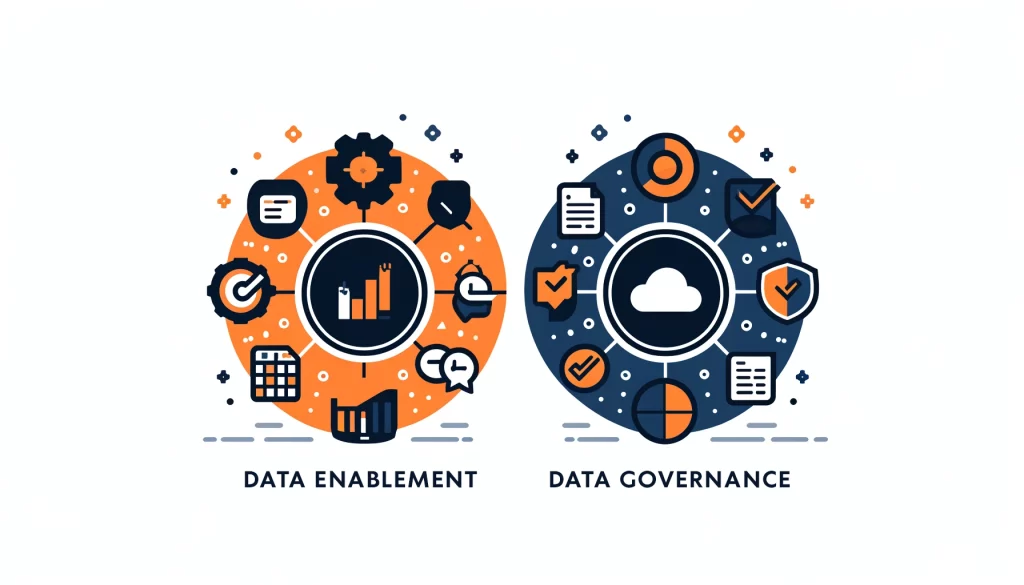
Data Enablement vs Data Governance

Nowadays, Two key approaches to data management are present: data enablement and data governance. While both methods aim to optimize data usage, they serve distinct purposes and employ different strategies.
This article will explain how data enablement and data governance collaborate to enhance data management in organizations. It emphasizes the benefits and significance of these two practices. Data enablement and data governance play a crucial role in improving data management within organizations. Their collaboration can lead to more efficient and effective data handling processes.
What is Data Enablement?
Data enablement is about giving employees the tools they need to access and analyze data easily.
Data enablement aims to make data more accessible to employees so they can make informed decisions and drive business success.
Organizations need to ensure that employees can access relevant data easily. The data should be accessible regardless of its source or organization. This will help achieve data empowerment within the organization.
This means using tools that allow employees to analyze and understand data independently. They can do this without relying on IT or data science teams for assistance.
The Benefits of Data Enablement
Data enablement offers several key benefits to organizations. By empowering employees with easy access to data, organizations can foster a culture of decision-making. This leads to improved collaboration, innovation, and ultimately, better business outcomes.
One of the primary advantages of data enablement is its decentralized approach. Each team and department can control their data, but also use a central platform to bring all the data together.
This method allows teams to have more control over their data. It also makes it easier for teams to customize data resources to meet their specific needs.
What is Data Governance?
Data governance is a structured way to manage data by making rules, processes, and guidelines for data management.
It ensures data is accurate, reliable, secure, and follows rules and standards.
Data governance typically includes a central team. This team is responsible for creating and enforcing rules and processes for managing data across the company.
This team creates and enforces data standards, policies, and procedures. They also ensure that regulations and standards are followed. This team typically comprises data stewards, data owners, and other professionals in the field of data management.
The Benefits of Data Governance
Effective data governance offers numerous benefits to organizations. Data governance ensures that data is accurate, reliable, and secure, helping organizations make better decisions and avoid costly mistakes.
It also helps organizations maintain compliance with relevant regulations and standards, reducing the risk of penalties and reputational damage.
Data governance also plays a critical role in managing metadata, data quality, and data lineage.
Organizations can keep their data accurate, reliable, and trustworthy by setting clear policies and procedures.
Combining Data Enablement and Data Governance
While data enablement and data governance serve different purposes, they are not mutually exclusive. In fact, combining these two approaches can lead to more effective data management and better business outcomes.
To effectively combine data enablement and data governance, organizations should begin by creating a clear data strategy. This plan needs to clearly outline the goals and objectives for managing data. It should also define the roles and responsibilities of all team members.
This plan should explain the responsibilities of managing data and making data accessible, making sure they support business goals.
Next, organizations should incorporate data enablement policies and procedures into their data governance framework.
By doing this, they can ensure that data is correct, trustworthy, safe, and easy to access for those who need it. This can help improve decision-making across the organization and drive better business outcomes.
Finally, organizations should consider using tools that combine data enablement and data governance. These tools can help streamline data management processes and ensure that data is both accessible and secure.
Common Misconceptions
Many organizations struggle to use data effectively and implement data governance because of common misconceptions. These misconceptions can hinder the successful utilization of these strategies. Despite the clear benefits of using data effectively and implementing data governance, organizations may still face challenges.
A common misunderstanding is that data governance is excessively strict and unyielding, impeding innovation and creativity. However, efficient data governance is intended to be adjustable and flexible, fostering innovation by guaranteeing that data is precise and dependable.
Another common misunderstanding is that enabling data without restrictions can lead to data chaos and security risks.
Data enablement sets rules for accessing and using data, making sure users are trained in managing data properly.
Real-World Examples of Data Enablement vs Data Governance
To better understand the differences between data enablement and data governance, let’s look at some real-world examples.
A retail company put in place a data strategy to help its marketing team easily access customer data.
The company improved marketing and sales. They did this by giving the team self-service analytics tools. They also provided a central data platform for better data access.
On the other hand, a healthcare organization implemented a data governance framework to ensure compliance with HIPAA regulations.
The organization reduced the risk of data breaches and maintained patient trust. They did this by creating clear policies and procedures for managing patient data. This helped ensure that patient information was kept secure and confidential. The organization’s efforts also helped to build a strong relationship of trust with patients.
The Future of Data Enablement and Data Governance
Data is becoming more important for business success. Effective data management will become even more important in the future.
Organizations that use data effectively and follow data management rules will achieve better business results. They will be able to maximize the potential of their data. This will lead to improved performance and success in their business operations.
Looking ahead, we can expect to see continued innovation in data enablement and data governance tools and technologies. AI and machine learning are already used to automate data management and enhance data quality.
As technology improves, organizations will have better tools to manage and use their data.
Conclusion
Data enablement and data governance are two critical approaches to data management that serve distinct but complementary purposes.
While data enablement focuses on empowering employees with easy access to data, data governance ensures that data is accurate, reliable, secure, and compliant.
By combining these two approaches, organizations can maximize the value of their data assets and drive better business outcomes.
Organizations need a clear plan for data to be successful. They should include data enablement in their data rules. Additionally, they should use tools that combine these strategies.
